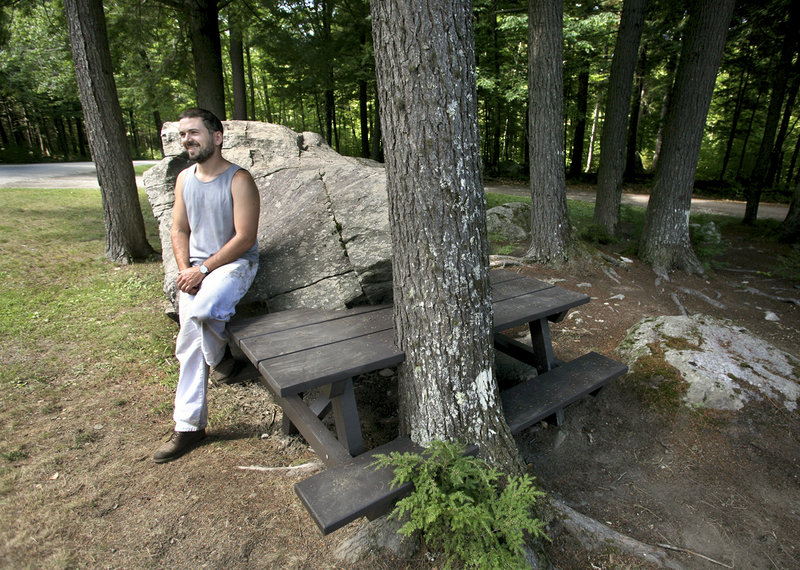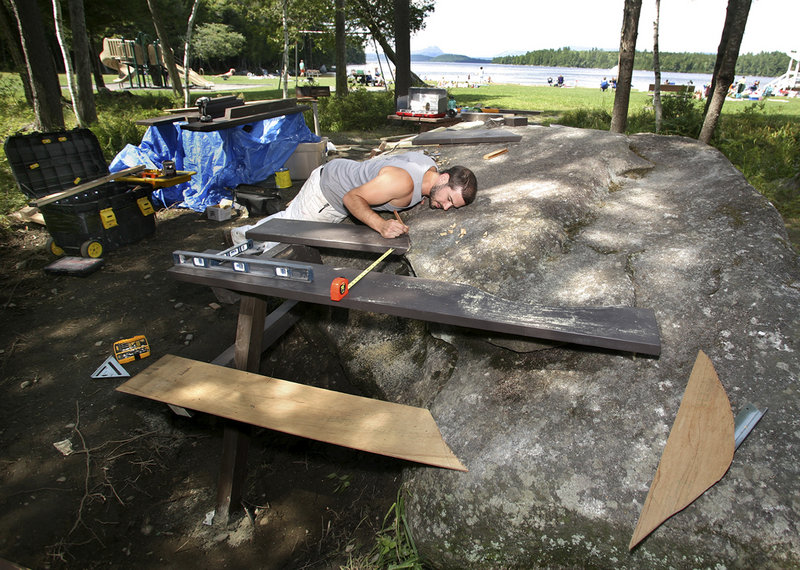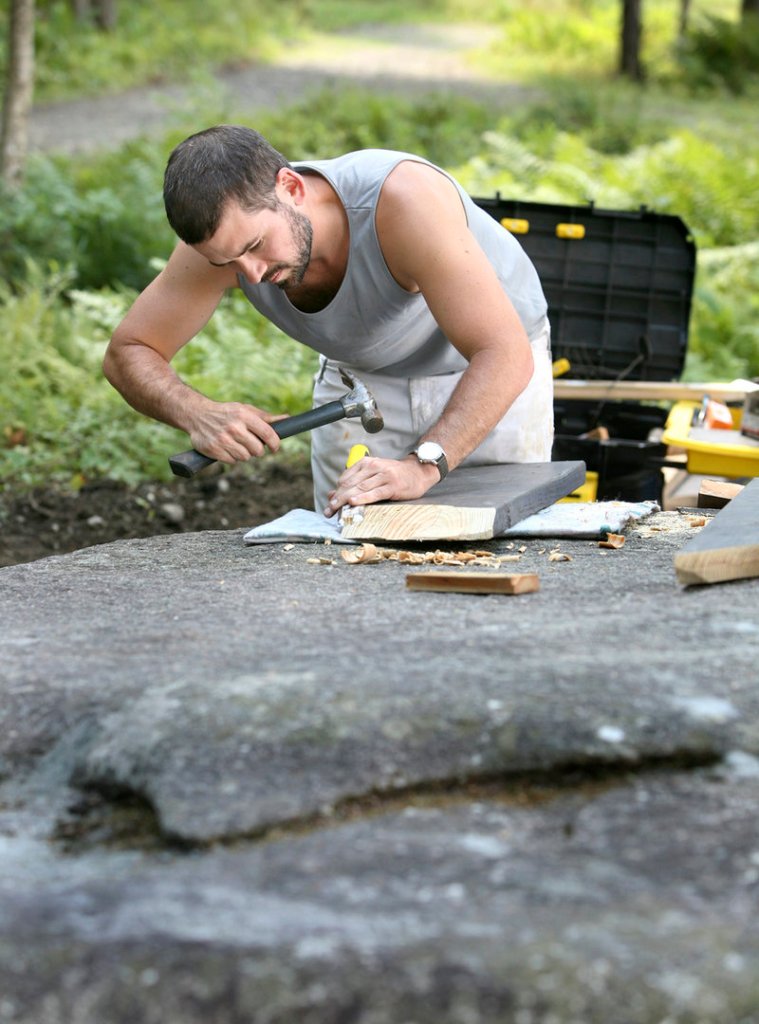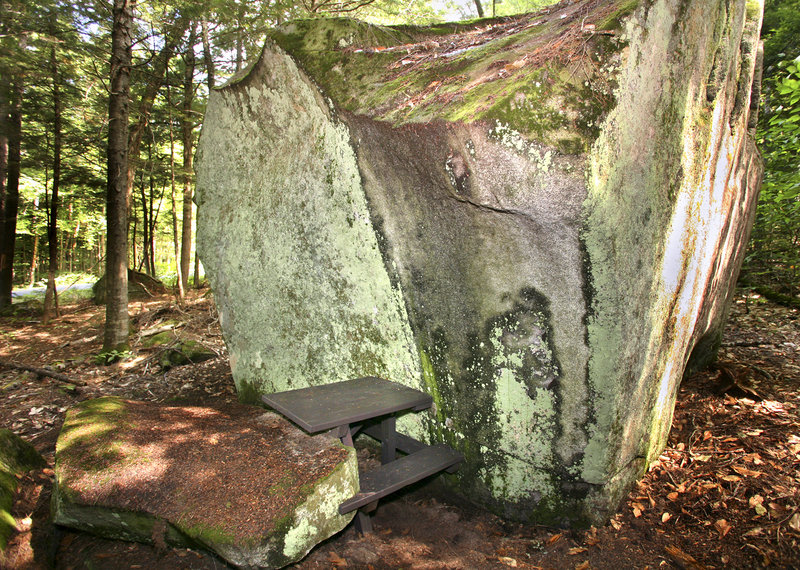DOVER-FOXCROFT – As a kid, Wade Kavanaugh came to Peaks-Kenny State Park on Sebec Lake for family outings.
Those were happy times, filled with frolicking in the water and exploring the hemlock forests and huge glacial rock formations that tumble out of the earth and give the park its spooky character.
His mom still has a photo of him as a youngster at the beach. It’s one of those precious family photos, forever on view in a prominent place in her home because of the memories associated with it.
So when Kavanaugh learned that Peaks-Kenny was seeking proposals for the first-ever public art project at the park, he was immediately interested.
“In fact, my mom was the one who sent me the posting for this opportunity,” said Kavanaugh, who grew up in Winthrop and lives in Albany Township, south of Bethel. “I’d never done a public project before. It’s fun to do something relatively local and safe, and something I know.”
Kavanaugh, a Bowdoin College-trained sculptor, usually works in grand scale, creating large interior installations that invite viewers to consider their relationships with natural and man-made architecture. Typically, he transforms gallery spaces into caves, forests and glacial floes. That was his motif during the 2009 Portland Museum of Art biennial, when he built a huge indoor wall from false bricks made out of tiny slices of Sheetrock.
For the Peaks-Kenny project, Kavanaugh is turning that concept upside down. He is working small, and doing everything he can to not interfere with people’s enjoyment of the park’s natural beauty.
“I do not want to subtract from anything that is going on here,” he said.
COMMUNING WITH BOULDERS
Kavanaugh is making a series of oddly shaped and unlikely situated picnic tables. Using the same materials that park employees use to build traditional picnic tables, Kavanaugh is making table-and-bench units that tuck alongside boulders and around trees.
One of the first ones he completed appears to emerge from a massive rock. He built only a small portion of the table, allowing the imagination of visitors to complete the structure. In another, a large tree grows right through a cutout in the bench.
These are fully functional tables and benches, designed to lead park visitors into what Kavanaugh calls “the park’s natural architecture.”
In all, he will build a dozen of the tables. The project is called “Quarry,” and park manager Carter Smith says Peaks-Kenny will eventually publish a map with icons of the tables so that visitors can seek them out. Many will be hidden in the dark forest, and will not be obvious to folks casually hiking by.
“We don’t want these to be another bunch of tables for people to barbecue on. We’ve got enough of those already,” Smith said. “People come to this park for a lot of reasons. Some come for recreation, for picnics, for family time. Others come seeking solace and to connect with nature and the natural wonder of this place.”
Kavanaugh’s tables and benches will give the latter group a different opportunity to find what they are seeking. When they locate the picnic tables and sit at them, they will find themselves up close and personal with the park’s naturally occurring beauty in ways they likely have never before, Smith said.
“It’s kind of a special feeling to sit beside something this close, rather than just pass by,” said Smith, standing at the table that is built into the rock.
COMPLEMENTING, NOT IMPOSING
The trick in Kavanaugh’s project is its lack of imposition.
One of things he struggled with when devising his concept for the project was the realization that people do not come to Peaks-Kenny — or any park, for that matter — for art experiences. Certainly, he and his family did not when they came up for outings, nor does he today when he camps.
He wanted to design something that integrated art concepts into the park experience without being overt. On that front, he succeeded.
His picnic tables are not obvious or obtrusive. They are designed to complement nature and bring attention to specific park features. Kavanaugh has no intention of trying to improve the park’s beauty or impose high-minded art ideas on people’s park experience.
He wants to make their park experiences more tangible by placing the picnic tables in such places to put people physically closer to the things they come to the park to enjoy.
Kavanaugh’s picnic tables delete what he calls “the social space” that exists between the benches of traditional picnic tables. That space between the benches is a void, where people place their cook stove, food and eating utensils. Kavanaugh’s benches have no void. Instead, they have rocks and trees.
The tables are fully functional. They are oddly shaped, and sometimes awkwardly located. But there’s nothing to prevent someone from sitting down and eating lunch.
At least during the early stages of his construction, which will continue into the fall, Kavanaugh camped in the park. He wanted to be there day in and day out, to fall into the rhythm of the park’s natural cycle. He also wanted to observe how people used the park, so that he could make better and more informed choices about how and where to build his tables.
Throughout the process of construction, Kavanaugh has also come to terms with what public art is all about. He’s seen a lot of public art projects fail because they fall short of their goals. “They may have been a gem of an idea, but they have no access point. People could not relate,” he said.
He thinks — he hopes — that “Quarry” will succeed because his access points are universal. Everybody can relate to the idea of a picnic table, he said.
A PERCENT FOR ART PROJECT
Smith sat on the panel that chose Kavanaugh for the project. It included several representatives of the Bureau of Parks and Lands, which administers the parks, as well as artist Alan Bray and Elizabeth Finch, a curator at Colby College Museum of Art in Waterville.
The Peaks-Kenny project is a big step for the Bureau of Parks and Lands, said deputy director Alan Stearns. The $20,000 budget was paid for through the state’s Percent for Art program, which requires that a percentage of public investment be set aside for art. In 2007, voters approved a $7.5 million bond package for the state park system.
That meant $75,000 was earmarked for public art. In addition to the Kavanaugh project at Peaks-Kenny, the Bureau of Parks and Lands collaborated with the Schoodic International Sculpture Symposium to place a sculpture at Lamoine State Park down east.
Most of the bond money is being used for capital investments throughout the park system, Stearns said. Bath houses and picnic shelters are the most common kinds of improvements.
The parks bureau wanted the art to be completely separate from the capital investment project, Stearns said. “Rather than put stained-glass windows in a bath house, we decided to do something unique. We do not need art in an outhouse,” he said.
Stearns praised Kavanaugh for his pragmatic approach. His materials are exactly what the park uses already, and there is nothing lavish or precious about what he is making. If they rot, they can be replaced. If they get vandalized, they can be painted.
Further, the tables are designed, as much as possible, to be accessible for folks in wheelchairs. And perhaps most important, they should be a magnet for kids. They are fun, playful and whimsical, Stearns said.
“I was interested in the interaction of kids with whatever piece we commissioned,” he said. “I’m hopeful this piece will be all about park users touching, feeling, using and being excited about what they find when they get to the park.”
Staff Writer Bob Keyes can be contacted at 791-6457 or at:
bkeyes@pressherald.com
Send questions/comments to the editors.






